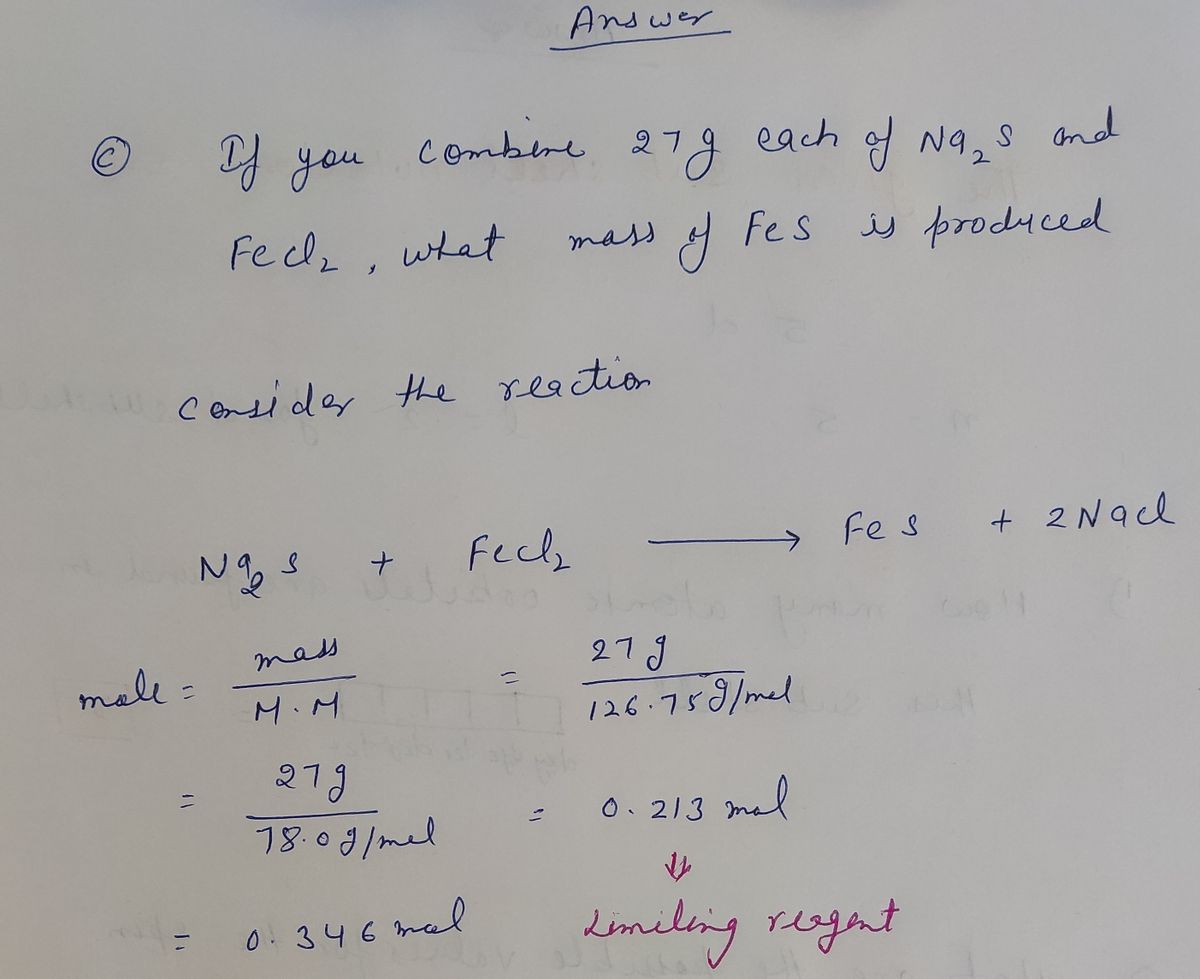### Educational Text: Stoichiometry and Limiting Reactants **Objective:** To find the amount of each reactant and determine the limiting reactant for the reaction between sodium sulfide (Na₂S) and iron(II) chloride (FeCl₂). **Calculations:** **1. Determine Moles of Each Reactant:** - For Na₂S: \[ \frac{27\, g\, \text{Na}_2\text{S}}{78.0\, g\, \text{Na}_2\text{S/mol}} = 0.346\, \text{mol\, Na}_2\text{S\, available} \] - For FeCl₂: \[ \frac{27\, g\, \text{FeCl}_2}{127\, g\, \text{FeCl}_2/\text{mol}} = 0.213\, \text{mol\, FeCl}_2\, \text{available} \] **2. Examine Ratio of Reactants:** The stoichiometric ratio required by the balanced equation is 1 mol Na₂S to 1 mol FeCl₂. - Calculated ratio from available reactants: \[ \frac{0.346\, \text{mol\, Na}_2\text{S}}{0.213\, \text{mol\, FeCl}_2} = 1.63\, \text{mol\, Na}_2\text{S to 1 mol FeCl}_2 \] **Conclusion:** Since 1 mol Na₂S is needed for every 1 mol FeCl₂, and the ratio of available reactants is 1.63 mol Na₂S to 1 mol FeCl₂, FeCl₂ is the limiting reactant. **Problem:** If you combine 27 g of each Na₂S and FeCl₂, what mass of FeS is produced? **Input Box:** Enter the mass of FeS produced in grams. This analysis helped identify FeCl₂ as the limiting reactant, meaning it will determine the amount of FeS produced.
### Educational Text: Stoichiometry and Limiting Reactants **Objective:** To find the amount of each reactant and determine the limiting reactant for the reaction between sodium sulfide (Na₂S) and iron(II) chloride (FeCl₂). **Calculations:** **1. Determine Moles of Each Reactant:** - For Na₂S: \[ \frac{27\, g\, \text{Na}_2\text{S}}{78.0\, g\, \text{Na}_2\text{S/mol}} = 0.346\, \text{mol\, Na}_2\text{S\, available} \] - For FeCl₂: \[ \frac{27\, g\, \text{FeCl}_2}{127\, g\, \text{FeCl}_2/\text{mol}} = 0.213\, \text{mol\, FeCl}_2\, \text{available} \] **2. Examine Ratio of Reactants:** The stoichiometric ratio required by the balanced equation is 1 mol Na₂S to 1 mol FeCl₂. - Calculated ratio from available reactants: \[ \frac{0.346\, \text{mol\, Na}_2\text{S}}{0.213\, \text{mol\, FeCl}_2} = 1.63\, \text{mol\, Na}_2\text{S to 1 mol FeCl}_2 \] **Conclusion:** Since 1 mol Na₂S is needed for every 1 mol FeCl₂, and the ratio of available reactants is 1.63 mol Na₂S to 1 mol FeCl₂, FeCl₂ is the limiting reactant. **Problem:** If you combine 27 g of each Na₂S and FeCl₂, what mass of FeS is produced? **Input Box:** Enter the mass of FeS produced in grams. This analysis helped identify FeCl₂ as the limiting reactant, meaning it will determine the amount of FeS produced.
Chemistry
10th Edition
ISBN:9781305957404
Author:Steven S. Zumdahl, Susan A. Zumdahl, Donald J. DeCoste
Publisher:Steven S. Zumdahl, Susan A. Zumdahl, Donald J. DeCoste
Chapter1: Chemical Foundations
Section: Chapter Questions
Problem 1RQ: Define and explain the differences between the following terms. a. law and theory b. theory and...
Related questions
Question
![### Educational Text: Stoichiometry and Limiting Reactants
**Objective:**
To find the amount of each reactant and determine the limiting reactant for the reaction between sodium sulfide (Na₂S) and iron(II) chloride (FeCl₂).
**Calculations:**
**1. Determine Moles of Each Reactant:**
- For Na₂S:
\[
\frac{27\, g\, \text{Na}_2\text{S}}{78.0\, g\, \text{Na}_2\text{S/mol}} = 0.346\, \text{mol\, Na}_2\text{S\, available}
\]
- For FeCl₂:
\[
\frac{27\, g\, \text{FeCl}_2}{127\, g\, \text{FeCl}_2/\text{mol}} = 0.213\, \text{mol\, FeCl}_2\, \text{available}
\]
**2. Examine Ratio of Reactants:**
The stoichiometric ratio required by the balanced equation is 1 mol Na₂S to 1 mol FeCl₂.
- Calculated ratio from available reactants:
\[
\frac{0.346\, \text{mol\, Na}_2\text{S}}{0.213\, \text{mol\, FeCl}_2} = 1.63\, \text{mol\, Na}_2\text{S to 1 mol FeCl}_2
\]
**Conclusion:**
Since 1 mol Na₂S is needed for every 1 mol FeCl₂, and the ratio of available reactants is 1.63 mol Na₂S to 1 mol FeCl₂, FeCl₂ is the limiting reactant.
**Problem:**
If you combine 27 g of each Na₂S and FeCl₂, what mass of FeS is produced?
**Input Box:** Enter the mass of FeS produced in grams.
This analysis helped identify FeCl₂ as the limiting reactant, meaning it will determine the amount of FeS produced.](/v2/_next/image?url=https%3A%2F%2Fcontent.bartleby.com%2Fqna-images%2Fquestion%2F144ac4d4-58bf-4a39-b1bc-5bb4c77f8379%2F5bab76e9-6139-40dd-8424-c41db28fa556%2Fmjpqre8.jpeg&w=3840&q=75)
Transcribed Image Text:### Educational Text: Stoichiometry and Limiting Reactants
**Objective:**
To find the amount of each reactant and determine the limiting reactant for the reaction between sodium sulfide (Na₂S) and iron(II) chloride (FeCl₂).
**Calculations:**
**1. Determine Moles of Each Reactant:**
- For Na₂S:
\[
\frac{27\, g\, \text{Na}_2\text{S}}{78.0\, g\, \text{Na}_2\text{S/mol}} = 0.346\, \text{mol\, Na}_2\text{S\, available}
\]
- For FeCl₂:
\[
\frac{27\, g\, \text{FeCl}_2}{127\, g\, \text{FeCl}_2/\text{mol}} = 0.213\, \text{mol\, FeCl}_2\, \text{available}
\]
**2. Examine Ratio of Reactants:**
The stoichiometric ratio required by the balanced equation is 1 mol Na₂S to 1 mol FeCl₂.
- Calculated ratio from available reactants:
\[
\frac{0.346\, \text{mol\, Na}_2\text{S}}{0.213\, \text{mol\, FeCl}_2} = 1.63\, \text{mol\, Na}_2\text{S to 1 mol FeCl}_2
\]
**Conclusion:**
Since 1 mol Na₂S is needed for every 1 mol FeCl₂, and the ratio of available reactants is 1.63 mol Na₂S to 1 mol FeCl₂, FeCl₂ is the limiting reactant.
**Problem:**
If you combine 27 g of each Na₂S and FeCl₂, what mass of FeS is produced?
**Input Box:** Enter the mass of FeS produced in grams.
This analysis helped identify FeCl₂ as the limiting reactant, meaning it will determine the amount of FeS produced.
Expert Solution
Step 1

Step by step
Solved in 2 steps with 2 images

Recommended textbooks for you

Chemistry
Chemistry
ISBN:
9781305957404
Author:
Steven S. Zumdahl, Susan A. Zumdahl, Donald J. DeCoste
Publisher:
Cengage Learning

Chemistry
Chemistry
ISBN:
9781259911156
Author:
Raymond Chang Dr., Jason Overby Professor
Publisher:
McGraw-Hill Education

Principles of Instrumental Analysis
Chemistry
ISBN:
9781305577213
Author:
Douglas A. Skoog, F. James Holler, Stanley R. Crouch
Publisher:
Cengage Learning

Chemistry
Chemistry
ISBN:
9781305957404
Author:
Steven S. Zumdahl, Susan A. Zumdahl, Donald J. DeCoste
Publisher:
Cengage Learning

Chemistry
Chemistry
ISBN:
9781259911156
Author:
Raymond Chang Dr., Jason Overby Professor
Publisher:
McGraw-Hill Education

Principles of Instrumental Analysis
Chemistry
ISBN:
9781305577213
Author:
Douglas A. Skoog, F. James Holler, Stanley R. Crouch
Publisher:
Cengage Learning

Organic Chemistry
Chemistry
ISBN:
9780078021558
Author:
Janice Gorzynski Smith Dr.
Publisher:
McGraw-Hill Education

Chemistry: Principles and Reactions
Chemistry
ISBN:
9781305079373
Author:
William L. Masterton, Cecile N. Hurley
Publisher:
Cengage Learning

Elementary Principles of Chemical Processes, Bind…
Chemistry
ISBN:
9781118431221
Author:
Richard M. Felder, Ronald W. Rousseau, Lisa G. Bullard
Publisher:
WILEY